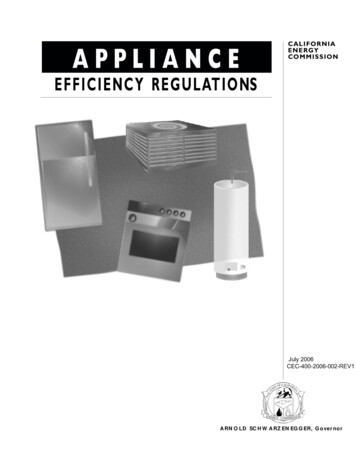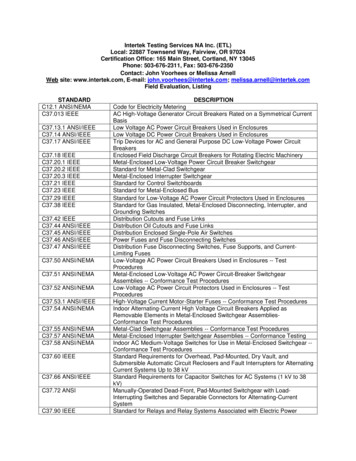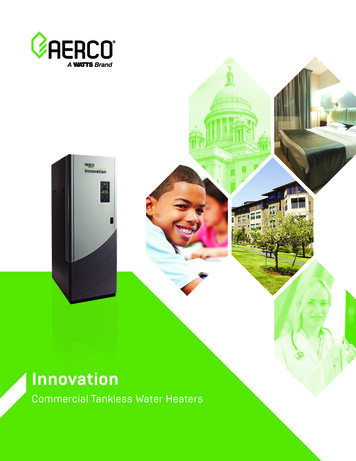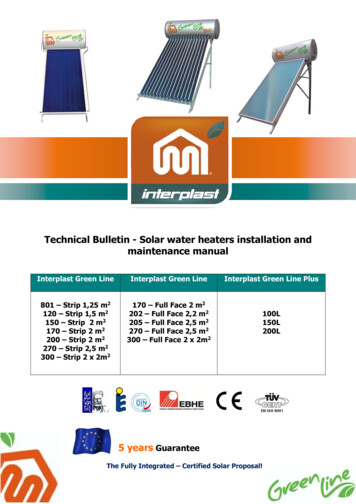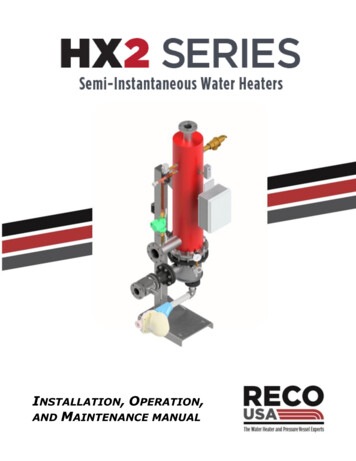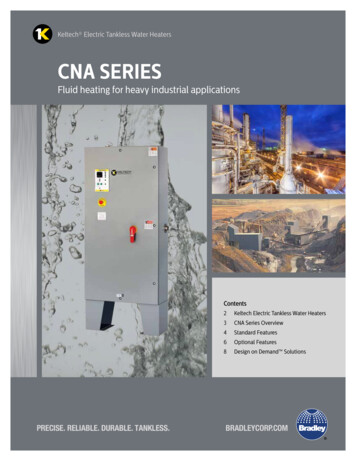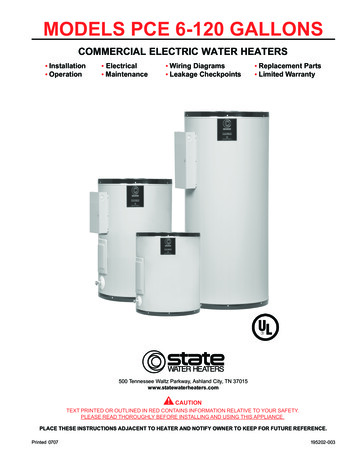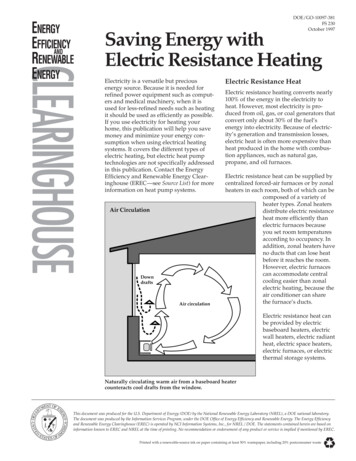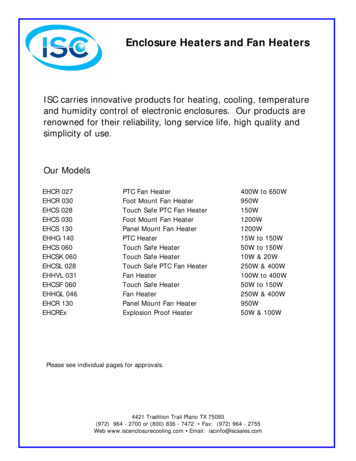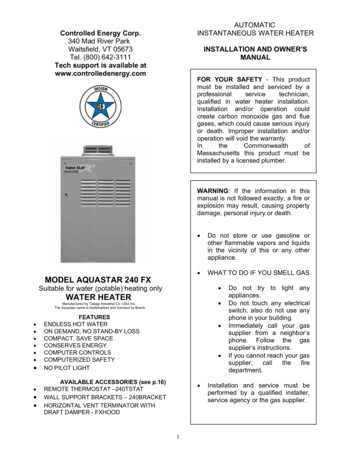
Transcription
2016 Title 24 Codes & Standards Enhancement (CASE) ProposalInstantaneous Water HeatersMay 20, 2014Sarah 0 ext. 202Bijit KunduBkundu@energy-solution.com510-482-4420 ext. 261
Stakeholder Meeting: Agenda Code change overviewSummary of current code requirementsTrendsMethodology for analysesInitial data and findingsProposed code requirementsSpecific stakeholder requests2
Proposed Code Change Overview Instantaneous Water Heaters (IWHs)– Natural gas, non-condensing, whole house Modification of prescriptive requirements for domestichot water systems New residential construction– Single Family– Multi-family (individual dwelling units with dedicated waterheater) Prescriptive requirement is baseline for performanceapproach (i.e. establishes energy budget for building)– Baseline is federal minimum Energy Factor (EF) rating of0.82 for gas IWHs (2015)3
Proposed Code Change Overview continued Developing alternative prescriptive path Performance path– Can meet energy budget via other strategies Installation of condensing storage water heater (EF0.82 or higher) Combination of upgrades that meet the energybudget4
Water Heating Product TypesTypes Instantaneous (typical EF 0.82 ) High efficiency storage (ENERGY STAR , EF 0.68) Standard storage (typical EF less than 0.67) Condensing storage (typical EF 0.82 ) Condensing instantaneous (typical EF 0.90 ) Point of use instantaneous (vs. whole house) Indoor or outdoorFuel sources Natural Gas Electric Liquid Propane SolarThis proposed code change:Reference and photo credit: AHRIWhole house gas, non-condensing instantaneous water heater(also known as “tankless” and “on-demand” water heater)5
Reasons for Proposed Code Change Water heating accounts for 49% of natural gasenergy consumption in California homes (RASS 2009) IWHs are typically more energy efficient than storagegas water heaters (no standby heat loss) IWH market share has expanded; lower unit costs This measure builds on the 2013 Title 24 mandatoryrequirements for domestic hot water systems By the time the 2016 Title 24 standards take effect in2017, builders will be accustomed to designing forhigher-efficiency water heaters6
Current Code Requirements: State 2013 Title 24 Requirements– Subchapter 7, Section 150.0(n) Water Heating System(mandatory requirements)– Subchapter 8, Section 150.1(c)8 Domestic WaterHeating Systems (prescriptive requirements) Currently, can install storage water heater or IWH7
Current Code Requirements: Federal Existing Standards– Gas IWH ( 2 gal): EF 0.62 – 0.0019*Vs orhigher– Gas Storage (20 to 100 gal): EF 0.67 – 0.0019*Vs orhigher Current ENERGY STAR– Gas IWH: EF 0.82– Gas Storage (20 to 100 gal): EF 0.67 Future Standards(effective April 2015)– Gas IWH ( 2 gal) EF 0.82 – 0.0019*Vs orhigher– Gas Storage: 20 to 55 gal EF 0.675 –0.0015*Vs or higher 55 to 100 gal EF 0.8012– 0.00072*Vs or higherVs Rated Storage Volume (gallons)8
Federal Preemption This measure would not violate federal building codepreemption provisions in EPCA (42 USC 6297(f))– Measure would not establish a standard level that exceedsthe federal minimum for equipment– Measure would not prohibit the installation of storage waterheaters– Measure will provide an alternative for prescriptivecompliance Instead, measure resets baseline building design toreflect EF rating for IWH, which meets but does notexceed the federal minimum standard9
TrendsIncreased market penetration– 1995 – 2005 - 24% increase in number of IWHs installed (Kema, 2008)– 2004 – 2011 - 61% increase in Internet searches for IWHs (NEEA 2011)– 2015 - 43% natural market share for IWHs (DOE 2010)Drivers– Update of Federal standards– ENERGY STAR and rebate programs– Title 24 compliance credits– Decreasing unit costs– Growing interest in other benefits (e.g., lower utility bills)10
Methodology for Energy SavingsAssumptions– For first year and annual statewide energy savings Comparing natural gas consumption of the 2015 federal minimumefficiencies for (1) 50 gallon storage and (2) instantaneous– Prototype Building Residential: 2,500 SF, two-story– Hot water draw schedule and distribution loss multipliers(found in RACM Appendix E)– New construction forecasts– Product lifespan11
Methodology for Cost AnalysisThe following inputs will be included in the cost analysesfor storage and instantaneous equipment: Equipment costs Installation costs Maintenance costs Equipment lifetime Natural gas TDV12
Initial Data and FindingsIWHs were determined to be cost-effective for newsingle-family construction in every California climatezone13
Initial Data and Findings continued Preliminary energy savings calculation– Estimated statewide energy savings from proposedmeasure: 2.6 million therms Widespread availability of qualifying IWHs– CEC Appliance Database (April 2014) 12 manufactures 30 unique brands 817 models– ENERGY STAR Qualified Products List (April 2014) 1,248 models14
Initial Data and Findings continuedEquipment Cost Comparison and Assumptions Prices vary by WH type, brand, retailer, fuel source, max.BTU, storage capacity– Condensing storage heaters (EF 0.90 ) and LP/Propaneheaters (storage & IWHs) are more expensive– Least expensive products may no longer meet Federal standardsin 2015– Outdoor is less expensive Cost data from top 3 retailers– Sears– Lowes– Home Depot15
Initial Data and Findings continuedIncremental equipment cost: 500RetailerTypeManufacturerEFStorage (gal.) Max. BTUs Cost ( )Home DepotInstantaneousRheem (Paloma)0.82N/A180,0001,048Home DepotStorageRheem (Paloma)0.625040,000456Cost 0848LowesStorageAmerican WaterHeater Co.0.65040,000662Cost 0975SearsStorageAO SmithN/A5040,000561Cost Difference414* Note: The incremental cost includes only the cost difference between gas storage and gas IWHs. Since theTitle 24 mandatory standards require the installation of components to accommodate gas IWHs and condensingstorage water heaters, those costs are not considered as part of the incremental cost of moving from a gasstorage to gas IWH as proposed by this code change.16
Proposed Code RequirementsSection 150.1(c)(8)8. Domestic Water-Heating Systems. Water-heating systems shall meet the requirements of either A, B C, or D.A. For systems serving individual dwelling units, a single gas or propane storage type water heater with an input of 75,000 Btu perhour or less, and that meets the tank insulation requirements of Section 150.0(j) and the requirements of Sections 110.1 and 110.3shall be installed. For recirculation distribution systems, only Demand Recirculation Systems with manual control pumps shall beused.B. A. For systems serving individual dwelling units, a single gas or propane instantaneous water heater with an input of 200,000 Btuper hour or less and no storage tank, and that meets the requirements of Sections 110.1 and 110.3 shall be installed. Forrecirculation distribution systems, only Demand Recirculation Systems with manual control pumps shall be used.C. B. For systems serving multiple dwelling units, a central water-heating system that includes the following components shall beinstalled:i. Gas or propane water heaters, boilers or other water heating equipment that meet the minimum efficiency requirements ofSections 110.1 and 110.3; andii. A water heating recirculation loop that meets the requirements of Sections 110.3(c)2 and 110.3(c)5 and is equipped with anautomatic control system that controls the recirculation pump operation based on measurement of hot water demand and hot waterreturn temperature and has two recirculation loops each serving half of the building; andEXCEPTION to Section 150.1(c)8Cii: Buildings with eight or fewer dwelling units are exempt from the requirement for tworecirculation loops.iii. A solar water-heating system meeting the installation criteria specified in Reference Residential Appendix RA4 and with aminimum solar savings fraction of 0.20 in Climate Zones 1 through 9 or a minimum solar savings fraction of 0.35 in Climate Zones10 through 16. The solar savings fraction shall be determined using a calculation method approved by the Commission.D C. For systems serving individual dwelling units, an electric-resistance storage or instantaneous water heater may be installed asthe main water heating source only if natural gas is unavailable, the water heater is located within the building envelope, and a solarwater-heating system meeting the installation criteria specified in the Reference Residential Appendix RA4 and with a minimumsolar savings fraction of 0.50 is installed. The solar savings fraction shall be determined using a calculation method approved by theCommission. Recirculation pumps shall not be used.Note: TBD. An alternative prescriptive option that does not include instantaneous water heaters is currently being developed for thiscode change proposal.17
Proposed Code Requirements2013 Residential Alternative Calculation Method Reference ManualSTANDARD DESIGNIndividual dwelling units: The standard design is based on §150.1(c)8. Forsingle family dwelling or dwelling units served by a dedicated water heatingsystem, each dwelling unit has one small storage ( 75,000 Btu), 50 gallongas storage a gas instantaneous water heater, meeting minimum federalEnergy Factor standard (0.575 in 2014, 0.60 in 2015). (0.82 in 2015).18
Requests from Stakeholders We would like your input – Percentage of single family and multi-family dwellings thatspecify IWHs in the design– Average useful life of IWHs and storage water heaters– Typical maintenance practice and costs for IWHs andstorage water heaters Please provide input at Title24Stakeholders.com19
Questions?Sarah 0 ext. 202Bijit KunduBkundu@energy-solution.com510-482-4420 ext. 26120
Appendix: Initial Savings Calculation forProposed MeasureCalculationsHomes 108,849 Construction ForecastStorage Penetration74% 2009 RASSAEC (Therms/yr)147 2009 RASSSavings fromInstantaneous WaterHeatersTotal Savings(MTherms)22% Consumer Reports Testing2.60 Calculation21
D C. For systems serving individual dwelling units, an electric-resistance storage or instantaneous water heater may be installed as the main water heating source only if natural gas is unavailable, the water heater is located within the building envelope, and a solar water-heating system meeting the installation criteria specified in the .
